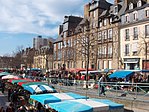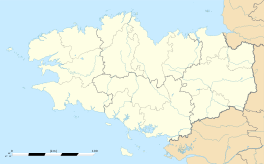Rennes
|
Rennes Roazhon pronounced [ˈrwaːzən] |
|||||||||
|---|---|---|---|---|---|---|---|---|---|
Top to bottom, left to right : City hall, Marché des Lices, Rennes Metro, Esplanade Charles de Gaulle, Opera of Rennes by night, University of Rennes 2, Skyline of Rennes from Cathedral
|
|||||||||
|
|||||||||
| Motto: Live in harmony (French: "Vivre en intelligence") | |||||||||
| Coordinates: 48°06′53″N 1°40′46″W / 48.1147°N 1.6794°WCoordinates: 48°06′53″N 1°40′46″W / 48.1147°N 1.6794°W | |||||||||
| Country | France | ||||||||
| Region | Brittany | ||||||||
| Department | Ille-et-Vilaine | ||||||||
| Arrondissement | Rennes | ||||||||
| Intercommunality | Rennes Métropole | ||||||||
| Government | |||||||||
| • Mayor (2014-2020) | Nathalie Appéré (PS) | ||||||||
| Area1 | 50.39 km2 (19.46 sq mi) | ||||||||
| Population (2013)2 | 211,373 | ||||||||
| • Density | 4,200/km2 (11,000/sq mi) | ||||||||
| Time zone | CET (UTC+1) | ||||||||
| • Summer (DST) | CEST (UTC+2) | ||||||||
| INSEE/Postal code | 35238 / 35000, 35200, 35700 | ||||||||
| Elevation | 20–74 m (66–243 ft) (avg. 30 m or 98 ft) |
||||||||
|
1 French Land Register data, which excludes lakes, ponds, glaciers > 1 km² (0.386 sq mi or 247 acres) and river estuaries. 2Population without double counting: residents of multiple communes (e.g., students and military personnel) only counted once. |
|||||||||
1 French Land Register data, which excludes lakes, ponds, glaciers > 1 km² (0.386 sq mi or 247 acres) and river estuaries.
Rennes (French: [ʁɛn]; French: Rennes, Gallo: Resnn, Breton: Roazhon, Latin: Condate, Civitas Redonum) is a city in the east of Brittany in northwestern France at the confluence of the Ille and the Vilaine. Rennes is the capital of the region of Brittany, as well as the Ille-et-Vilaine department.
Rennes's history goes back more than 2,000 years, at a time when it was a small Gallic village named Condate. Together with Vannes and Nantes, it was one of the major cities of the historic province of Brittany and the ancient Duchy of Brittany. After the French Revolution, Rennes remained for most of its history a parliamentary, administrative and garrison city of the Kingdom of France.
Since the 1950s, Rennes has grown in importance through rural flight and its modern industrial development, partly automotive. The city developed extensive building plans to accommodate upwards of 200,000 inhabitants. During the 1980s, Rennes became one of the main centres in telecommunication and high technology industry. It is now a significant digital innovation centre in France.
In 2015, the city is the tenth largest in France, with a metropolitan area of about 700,000 inhabitants. With more than 63,000 students in 2013, is also the eighth-largest university campus of France. The inhabitants of Rennes are called Rennais, Rennaise in French. In 2012, l'Express named Rennes as "the most liveable city in France".
...
Wikipedia











